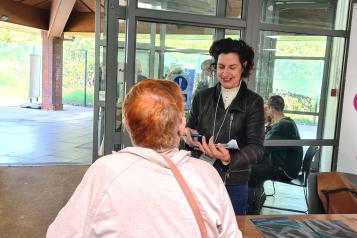How to support patients living with dementia

Kate Hudson, Lead Dementia Nurse Specialist explained: "Sometimes our patients living with dementia can become restless, agitated, or anxious. Twiddle muffs and fidget mats can provide a source of visual, tactile, and sensory stimulation which can help reduce anxiety and increase wellbeing and relaxation."
How to make a twiddle muff
A twiddle muff is a knitted hand warmer with sensory items attached. It contains strands of textured ribbons, beads and various fabrics which may be on both the inside and outside. If some of the bits and bobs – such as buttons, beads, tassels, and ribbons – are on the inside of the twiddle muff, hands can be kept active and warm at the same time.
Materials
- This muff pattern is perfect for using up left over and odd balls of wool.
- Different textures of wool are also good for stimulation.
Needles
- 6.5mm straight needles or 8mm circular.
- Beads, zips, ribbons things that can be twiddled with but will not break and are not sharp to touch or brittle.
Cuff (Twiddle muff lining)
- Cast on 40 stitches using 2 strands of double knitting wool. You can also use 1 strand of chunky wool.
- Work in stocking stitch (knit a line, purl a line) for 11 inches (28cm).
Muff Body
- Continue with stocking stitch and use up any oddments of various textures of wool.
- For example chunky, mohair, snuggly, eskimo, ribbon and chenille.
- Knit unit work until it measures 23 inches (58.5cm).
- Cast off.
Finishing and decoration
- Neatly sew the long edges together with purl side facing you.
- Turn the muff inside out.
- Push the cuff (lining) up inside the muff body and neatly sew the case on and cast off edges together.
Now is the time to decorate your Twiddle muff. Here are a few things to consider:
- Choose a good variety of decorations: beads, pastel colours, depending on whether the Twiddle muff is a male or a female.
- Try to include at least six decorations on the outside and four on the inside. You can add more if you like.
- Make sure everything is sewn on tight so they cannot be pulled off and there are no loose threads.
- Include bits and bobs on the inside too. Agitated hands can then be soothed and kept warmed at the same time.
How to make a fidget mat
Fidget mats are lap-top sized, can be quilted, knitted or crochet, and decorated with things to provide sensory and tactile stimulation, such as left-over wool, strings, buttons, zips, buckles, bells, fabric in different textures, soft toys, beads etc.
Fidget mat
The size of your fidget mat is up to you; the dimensions below make a lap mat as per the photo that can be tied at the waist or positioned on a table with velcro.
What you need
- Volunteers and sewing machines. Not all volunteers need to know how to sew; they can decorate, cut fabric, and separate items for personalised mats.
- Decorations: Leftover wool, strings, buttons, zippers, buckles, bells, fabric in different textures, soft toys, squishy and squeaky items, key rings, beads, and more.
- Stiff stabilizer, fusible on both sides. – 1 piece 24 X 19 inches or 56 X 47 cm
- Fabric - 2 pieces (front and back) - 24 X 19 inches or 56 X 47 cm
Assembly
- Lay first piece of fabric right side up on a table
- Lay second piece of fabric, right side down (on top of first fabric)
- Lay stabilizer on top of fabrics
- Sew around and leave one side open
- Turn fabric layers inside out
- Now you have the interfacing between the two layers of the mat fabric
- Finish mat’s open side by folding inwards and sewing shut.
- Iron the mat well to allow the interface to fuse
- Sew all around the 4 sides of the mat once more to finish the base.
Decorating
Use your imagination; anything interesting and safe is suitable. Decorations should be securely attached to fabric for safety reasons.
For example: Sew on a zipper, attach buttons, make a button hole for large buttons with button flaps, sew in a bunch of wool strands (about 7 inches/18cm - to be braided); attach belt and buckle, sew in a fluffy piece of fabric and leather, attach pom-poms, squish toys, and more. Attach soft toys, sew in a little pocket, large colourful beads, key ring and attach it to mat.
Or you can simply knit squares
Cast on one stitch on every row until you reach the half size of square you want - so for example for 50 rows - then cast off each row until you are down to one stitch - cast that off and you have a square.
You can then either sew or crochet them together into a shawl or blanket - or give them to us as they are and we’ll do it.
Remember that people living with dementia must be supervised.


